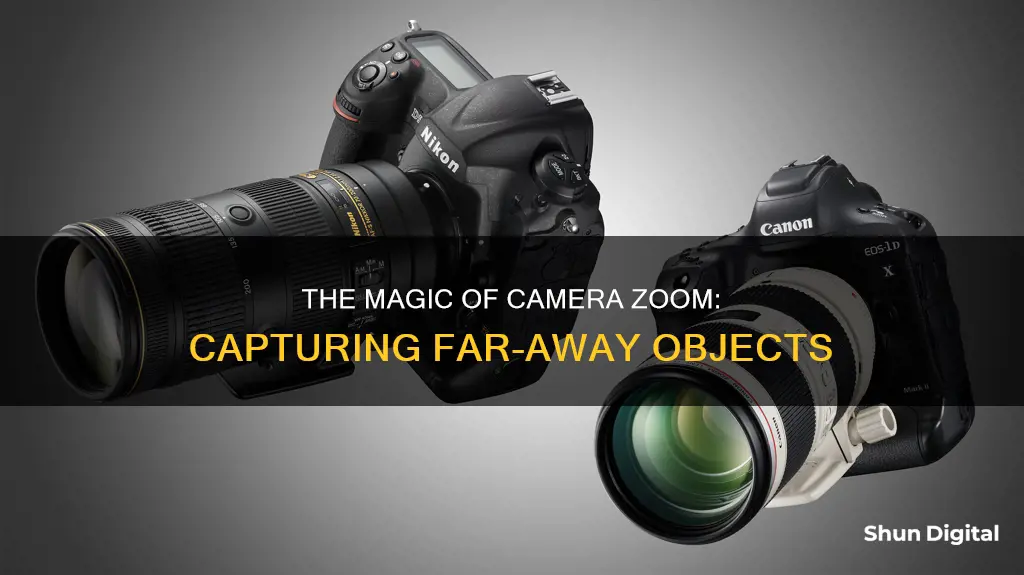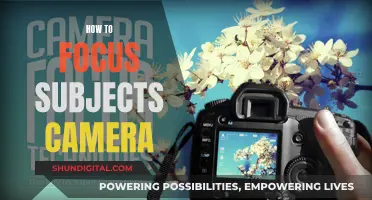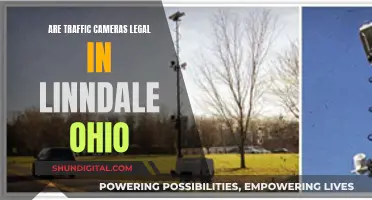
Focusing is a crucial technique in photography, ensuring that the desired subject is in focus and not blurry. The process of focusing involves adjusting the lens to direct light rays onto a specific point, known as the plane of focus, to create a sharp image. This is particularly important when capturing fast-moving subjects, such as birds in flight, or in low-light conditions. One term related to focusing in photography is depth of field, which refers to the range of distances within a photo that appear sharp. When focusing on far-away objects, photographers may utilise a technique called racking focus, where the area of sharp focus shifts from one plane to another during the shot, bringing distant objects into view.
| Characteristics | Values |
|---|---|
| Definition | The process of a camera focusing on far-away objects |
| Technical Term | Deep focus |
| Other Terms | Deep space, deep depth of field |
| Description | The use of the camera lens and lighting that keeps objects in both close and distant planes in sharp focus |
| Measurement | The distance in which objects will still produce a reasonable or acceptably sharp image |

Autofocus vs Manual Focus
Autofocus (AF) and manual focus (MF) are two methods of achieving a clear shot with your camera. Autofocus is when the camera sets the focal point, while manual focus lets the photographer determine the focal point.
Autofocus
Autofocus is generally faster than manual focus, although its speed depends on the camera and lens type. Sports-oriented equipment, for example, is designed to be much faster. Autofocus has also seen advancements such as tracking, which enable the camera to lock focus on a subject and follow it through the frame. This feature is particularly useful for capturing moving subjects.
Autofocus systems rely on contrast to identify objects, so they struggle in low-contrast scenes, such as those with heavy backlight. They also depend on light to function, so they perform poorly in low-light conditions. Autofocus can also be confused by scenes with many objects, as they tend to focus on foreground objects. They are also not very precise, so while they can get you close to your desired focal point, they may not be able to focus exactly where you want them to.
Manual Focus
Manual focus gives the photographer greater creative control, as they can determine the exact focus point. This method is ideal for situations where autofocus may struggle, such as in low light conditions, when shooting through glass or fences, or when there are many objects in the scene. It is also more precise, allowing the photographer to carefully pick the point of focus from a chaotic scene.
However, manual focus is generally slower than autofocus, making it less suitable for capturing moving objects. It also requires the photographer to choose the point of focus, which can be challenging in certain situations, such as when shooting from the hip.
When to Use Autofocus
Autofocus is generally recommended as the default option, especially when photographing wildlife on the move, birds in flight, street photography, or pets at play.
When to Use Manual Focus
Manual focus is best used in specific scenarios where autofocus struggles. This includes macro photography, deep landscape photography, complex focus bracketing, scenes with many distracting foreground elements, and situations where you need to nail a precise point of focus, such as portrait photography. It is also ideal for nightscapes or any scenes with low light, as well as situations where you know where your subject will be in advance, such as a bird flying to the same perch.
Foscam Camera Production Origins: Where Are They Made?
You may want to see also

Zoom Lenses
The convenience of variable focal length comes at the cost of increased complexity, weight, dimensions, and a potential compromise on image quality, autofocus performance, and cost. All zoom lenses suffer from at least a slight loss of image resolution at their maximum aperture, especially at the extremes of their focal length range. This effect is particularly noticeable in the corners of the image when displayed in a large format or high resolution. The greater the range of focal lengths offered by a zoom lens, the more these issues are likely to be exaggerated.
Some examples of zoom lenses include the Sony FE 200-600mm f/5.6-6.3 G Master OSS, which is great for astrophotography due to its large focal length, and the Nikon Z 70-200mm f/2.8 S, which offers excellent image quality and optical image stabilization. Other options include the Canon RF 28-70mm f/2L USM, which produces high-quality images but comes with a high price tag, and the Sigma 70-200mm f/2.8 DG OS HSM, which offers similar performance to more expensive lenses at a more affordable price point.
Testing Vintage Polaroid: Battery Check for 1-Step Cameras
You may want to see also

Aperture
The size of the aperture is measured in f-stops, with smaller f-stops like f/1.8 representing a wide opening, and larger f-stops like f/22 indicating a narrow one. Lower f-stops result in more exposure, as they represent larger apertures, while higher f-stops produce less exposure due to their smaller size. This relationship may seem counterintuitive at first, but it becomes clearer through experimentation with different f-stops.
In addition to its impact on depth of field, aperture also affects shutter speed. A lower f-stop, or larger aperture, allows more light to enter the lens, enabling a faster shutter speed. Conversely, a higher f-stop and smaller aperture reduce the amount of incoming light, necessitating a slower shutter speed to achieve proper exposure.
Moreover, aperture contributes to the bokeh effect, which refers to the aesthetic quality of the background blur in an image. A wide aperture produces pleasing bokeh, making it a popular choice for portrait photography to achieve a soft, unfocused background.
In summary, aperture is a fundamental concept in photography that governs various aspects of an image, including depth of field, shutter speed, exposure, and bokeh. By adjusting the aperture, photographers can creatively manipulate the amount of light entering the camera, influencing the final image's overall appearance and mood.
Customizing Your FO76 Camera: A Step-by-Step Mod Guide
You may want to see also

Depth of Field
The term "depth of field" (DoF) refers to the distance between the closest and farthest objects in a photo that appears acceptably sharp. In other words, it is the area in front of and behind the subject that is in focus.
By adjusting these factors, photographers can control the depth of field to achieve the desired effect. For example, a shallow depth of field can be used to highlight a specific subject or create a soft, blurred background. On the other hand, a large depth of field is often used in landscape photography to keep most of the scene in focus.
Understanding depth of field is crucial for photographers to master as it provides artistic freedom and allows them to create the images they envision.
Focusing Your Camera on Snapchat: A Quick Guide
You may want to see also

Focal Length
For example, a 500mm lens has a longer focal length than a 50mm lens, and will therefore produce images that are more "zoomed in". In practice, photographers use different focal lengths to capture different types of images. Wildlife photographers, for instance, tend to use longer focal lengths to get closer to their subjects without being seen, whereas landscape photographers typically use shorter focal lengths to capture wide vistas.
There are two types of lenses: prime and zoom. Prime lenses have a fixed focal length, whereas zoom lenses have variable focal lengths. Zoom lenses are more versatile and convenient as they allow photographers to access multiple focal lengths without needing to change lenses. However, prime lenses tend to be more compact and lightweight, sharper, with larger maximum apertures that perform better in low-light conditions.
Latest Camera Raw Update for CS5
You may want to see also
Frequently asked questions
The term for this process is "focusing". Focusing is when the camera lens changes the optical path of light to bring the object into sharp focus.
Autofocus is when the camera system automatically focuses on a subject, either selected by the photographer or detected by the camera. Manual focus is when the photographer physically adjusts the lens to bring the desired object into focus.
A shallow depth of field means that only objects within a narrow range of distances will be in focus, with objects closer to and farther from the camera appearing blurry. A deep depth of field means that objects across a wider range of distances will appear sharp and in focus.
The focal length of a lens determines the angle of view and the magnification of the image. A longer focal length will result in a narrower angle of view and higher magnification, making objects appear larger and closer.







